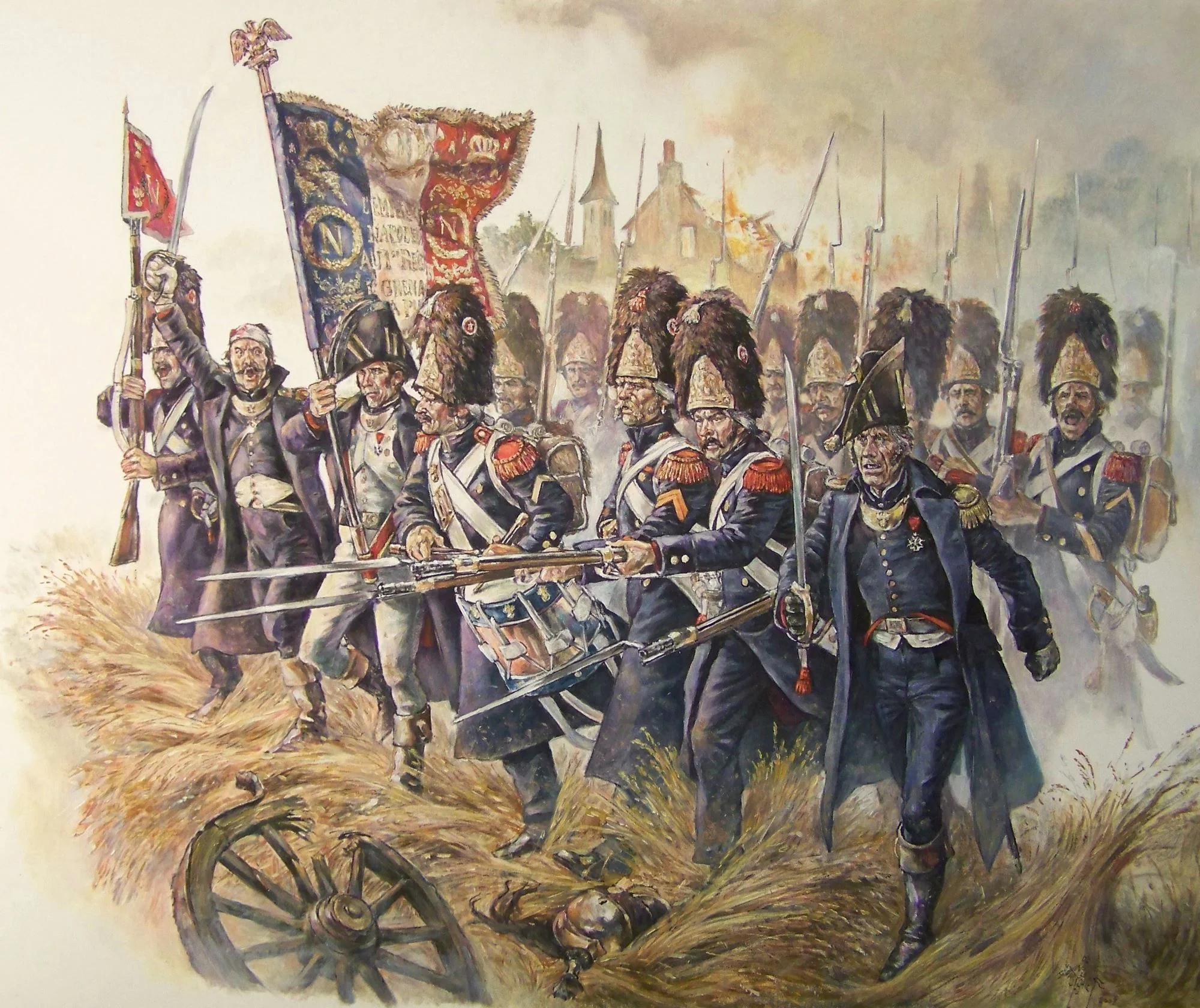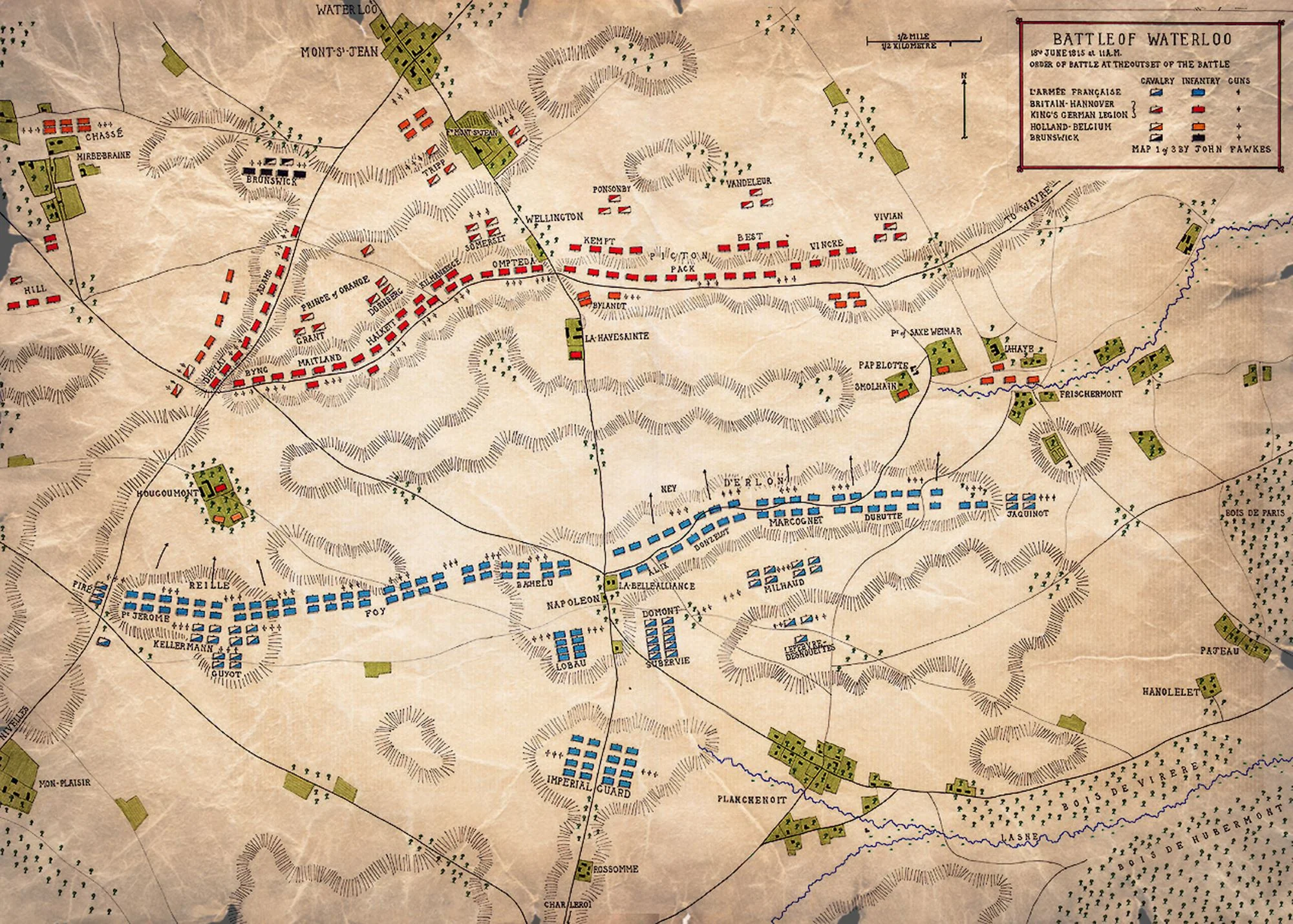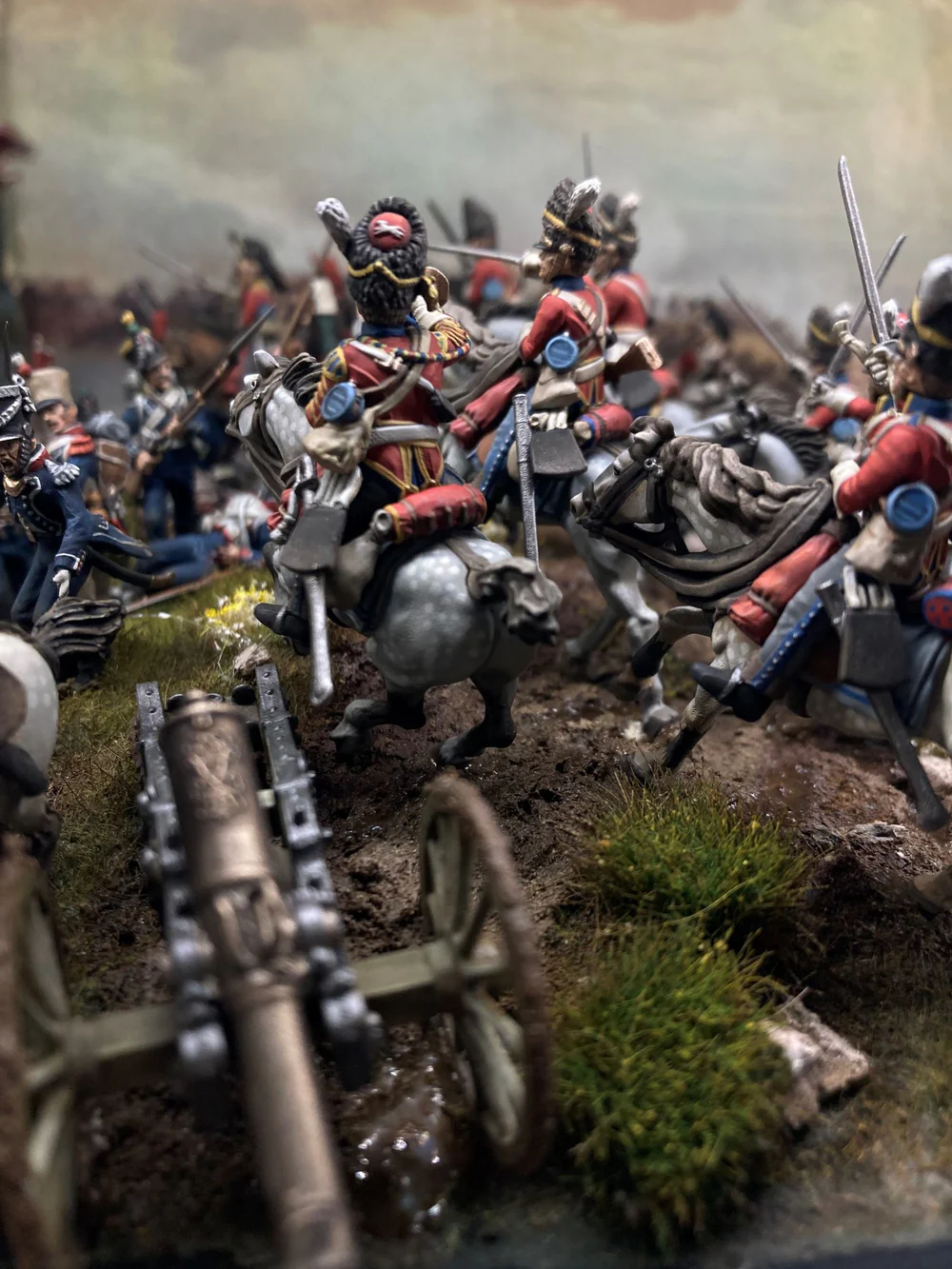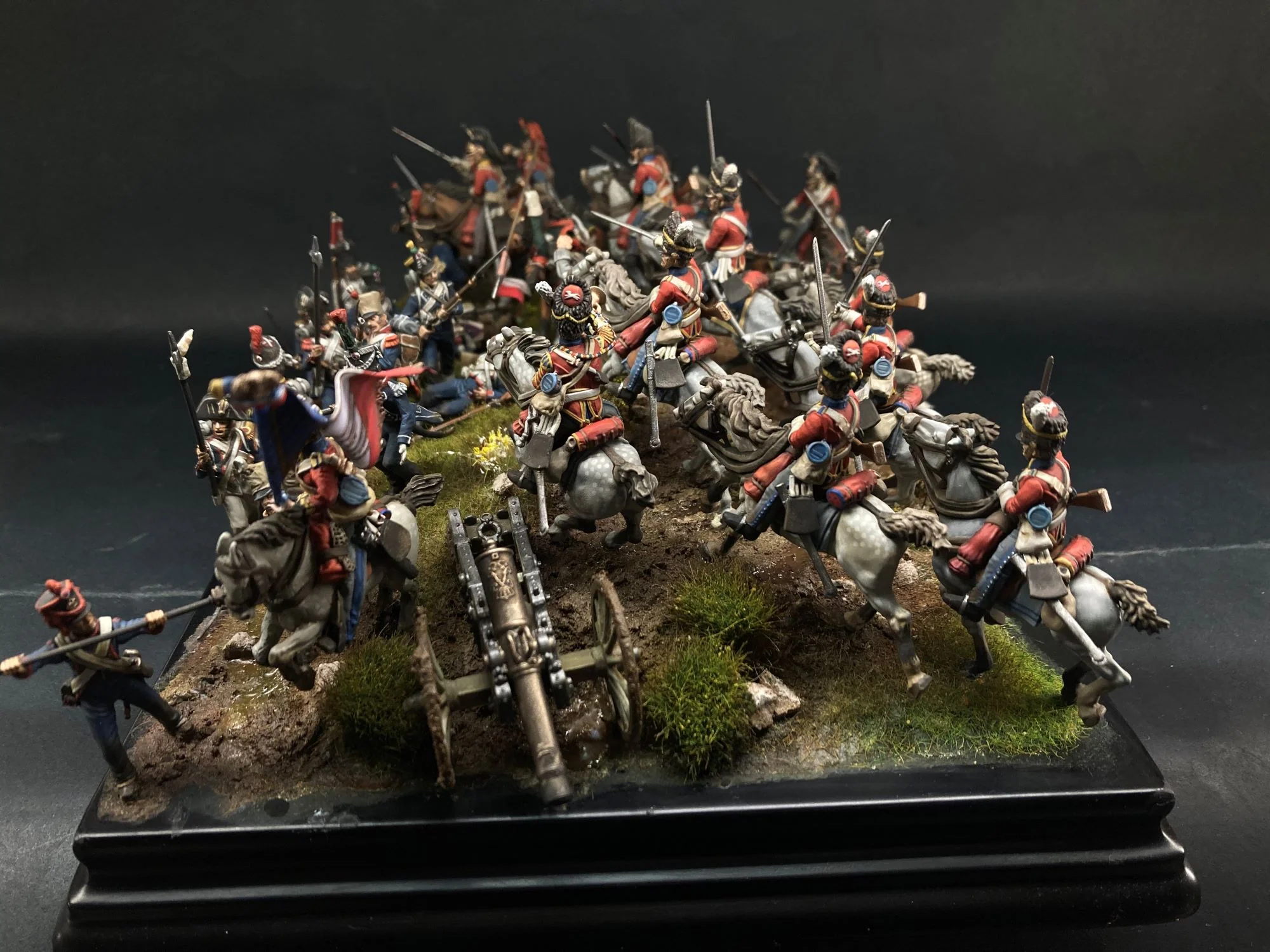Background
Napoleon Returns
Napoleon had abdicated as Emperor of the French in 1814, putting an end to nearly 25 years of ceaseless war between the great powers of Europe. Louis XVIII, the plump and gout-stricken brother of Louis XVI, was put on the throne of France and the allied victors, Britain, Russia, Austria and Prussia set to dividing the spoils of war in Vienna.
Marching on Paris
After a year of brooding in exile over his past glories on the island of Elba. Napoleon escaped with 1,200 men and arrived once more on the shores of France. Louis’ total underestimation of the threat of Napoleon paired with his failure to purge the military of its Bonapartist troops led to mass desertions as Napoleon rapidly marched on Paris. On 19 March 1815, the army stationed outside Paris defected to Bonaparte and Louis fled the city; the army and the Marshals had flocked around the Emperor’s eagles, Napoleon had returned.

Allied Mobilisation
The Coalition allies quickly declared war on Napoleon, and began to marshal their troops for an invasion of France to rid Europe of the “Corsican ogre” once and for all.
Two allied armies were raised in the Netherlands to oppose any French strike against Brussels; these were the Prussian army of roughly 120,000 men, under the hot-headed old warhorse, Marshal Blucher, and the Anglo-Dutch army of 108,000 men, under the Duke of Wellington. Napoleon had managed to gather 126,000 troops to counter these armies, however, outnumbered 2-1, Bonaparte had to act decisively to prevent Blucher and Wellington joining forces.
Napoleon Strikes
Napoleon unexpectedly struck first, crossing the Belgian frontier on the 15th June. The following day Napoleon engaged the Prussian army at Ligny, and gave Blucher a “damn good thrashing”. The Prussian centre gave way under heavy French attack but the flanks held their ground. Following several successful Prussian heavy cavalry charges, Blucher’s army was able to escape and regroup. French failure to immobilize the Prussian forces would later prove fatal at Waterloo, the town situated 30km north of Ligny.
The same day, Napoleon detached Marshal Ney to hold the Anglo-Dutch forces at the crossroads of Quatre Bras and thus drove a wedge between the two allied armies. Despite having failed to completely rout the Prussian army the French Emperor had bought time, there remained a chance of a decisive French victory, so long as Napoleon could swiftly crush the Anglo-Dutch army.
Quatre Bras was more or less a draw between allied and French but the French held field whilst the allied army retreated to their pre-prepared positions at Waterloo.


The Battle of Waterloo
There had been heavy rain the night before the battle and the troops on all sides woke wet and tired. The morning of the 18th the ground was sodden and the cloying mud made it difficult to move, hence, was not firm enough for the French artillery to operate properly. This causing a delay to the outset of the battle; time lost that would be crucial to the outcome of the engagement.
The assault on Hougoumont
At around 11.50 a.m. the battle began with an assault on Hougoumont, a farmhouse that the allies had fortified during the night that sat protecting the Anglo-Dutch right flank. This was stoutly defended by the British Guards in the buildings and other allied sharpshooters and skirmishers in the woods. Attacks were launched at Hougoumont throughout the day tying up thousands of elite French troops, a fraction of the manpower was required for the British to hold the farmhouse.

French central assault
Napoleon then assembled a Grand battery of 80 guns east of the Genappe road and began to pound the allied centre in preparation for an infantry assault on the allied front, positioned in a line along a sunken ridge overlooking the battlefield.
The French infantry divisions of generals Allix, Marcognet, Durutte and Donzelot advanced in large columns beating the pas de charge on the drums, to the cries of “Vive l’Empereur!”.
They drove back the allied skirmishers and some split off to attack the farm of La Haie Sainte, a second fortified complex located at the centre of the allied army.
The allied artillery raked the French columns with round-shot and cannister causing horrendous casualties, nonetheless, the French marched on relentlessly and crested the ridge. Heavy fighting ensued and the French infantry were briefly checked by British musket volleys. Armed with the Brown Bess musket, British infantry tended to fight in line formation, capable of firing 4 rounds a minute, a round more than most other European armies. Volley fire from a British line could devastate any attack.
British counter-attack
It was then that the British Household cavalry and Union Brigade were launched at the French. The Household cavalry drove back supporting French Cuirassiers, whilst the Union Brigade of the 1st, 2nd and 6th Dragoons smashed into Donzelot’s division. Lord Somerset and his Household Brigade swept into Allix’s division, initially a resounding success for the British cavalry. 2 French Eagles were captured and the French infantry were driven back in disorder.
The triumph of the British cavalry charges soon turned into a nightmare. They lost their heads and charged on hacking through the French grand battery and became tired and disorganised. The French cavalry counter attacked, killing Lord Ponsonby the commander of the Union brigade. Panicked, the British cavalry was driven back in a chaotic retreat. The British had lost half of their cavalry in a single wild action.
"Our officers of cavalry have acquired a trick of galloping at everything. They never consider the situation, never think of manoeuvring before an enemy, and never keep back or provide a reserve."



Ney's cavalry charge
The French launched cavalry attacks of their own led by marshall Ney, targeting the allied centre. The first wave comprising of 5,000 men then increasing to over 10,000. Their charge was targeted by artillery cannister and musketry from the British infantry who had formed into squares. They withdrew and charged again and again with fanatical heroism but failed to break the allied squares. Nonetheless serious damage was caused to the allied infantry squares by the French artillery, capable of raking the deep formations. Some regiments were so depleted they had to join with other regiments to form a cohesive square. The carnage was horrifying.
The Prussians arrive
At 4.30 pm Guns were heard to the southeast, The Prussians had arrived! Following the Prussian defeat at the battle of Ligny two days prior, Napoleon had tasked Marshal Grouchy to follow Blucher’s force with a whole third of the French army to ensure they were unable to link with the Anglo Dutch army. Grouchy had dithered away valuable time with a slovenly march, allowing the Prussians army to make its way to Waterloo, eventually launching an attack on the French eastern flank.

Napoleons final push
The French army was split having to fight off Prussian attacks whilst attempting to break through the British line. It was imperative for Napoleon to split the Anglo-Dutch centre so he could then turn on the Prussians. He ordered an all-out attack on La Haie Sainte, finally driving out the gallant defenders and then the French launched a desperate attack on the Allied centre.
The troops in the centre were holding but only just. The Allied army had shrunk from a strength of around 82,000 men to a mere 35,000. It was now Napoleon launched his last reserve and sent in the infantry of the Imperial Guard; 7 battalions in all and supported by as many other French infantry as they could scrape together. They assaulted the Allied ridge at two points but were unable to break through. They were met by point blank musketry from front and flanks pouring volley after volley into the dense French columns, until finally the unthinkable happened, the French guard broke. The cry of ‘La Garde Recule!’- ‘The Guard is retreating!’, filtered along the French lines. With this the French army disintegrated in retreat.
Napoleon defeated
The battle rumbled on for a few more hours across sections of the battlefield however the rout of Guard marked the end of any chance of French victory, the battle was over for Napoleon.
The allies lost around 15,000 men, the Prussians 7,000 and the French between 25,000 and 30,000. A terrible day of carnage and savagery over such a small battlefield.
Napoleon eventually was forced to abdicate once more and exiled to Saint Helena and so the Napoleonic wars finally came to an end.
The Armies
French Army
The Guard were renowned for their discipline and fighting ability and were never beaten until Waterloo. Battalions not committed to the assault on the British centre helped delay the allied advance when the rest of the French army ran and helped hold the Prussians on the flank as long as possible. When asked to surrender a Guard colonel shouted back ‘Merde!’ in defiance.
The Chasseurs a cheval and the Polish (blue) and Dutch (red) lancers of the guard were truly superb cavalry. They charged the British squares again and again dashing themselves against the muskets and cannons. They suffered terrible loss but were brave and would always carry out an order to the last.
There were 9 batteries of Guard Foot artillery armed with 12pdr guns. They wore the long-tailed coats and waistcoats of the Guard and tall bearskin headdress with red epaulettes. They formed part of the Grand battery that battered the Allied centre.
There were 22 batteries of Foot artillery in the French army during the Waterloo campaign. They were one of the Elite arms of the French army. General Picton commenting he had ‘never seen guns move so smoothly’.
British Army
-
The Household Brigade at Waterloo was commanded by Major General Lord Somerset, it consisted of the 1st and 2nd Life Guards and the Horse guards. These delivered the decisive charge against the French Cuirassiers and French infantry columns during the battle for the Allied central ridge leading to the capture of a French Eagle and the repulse of the French columns.
The Union Brigade at Waterloo, commanded by Major General sir William Ponsonby, consisted of the 1st Dragoons (English) 2nd Dragoons (Scots Greys) 6th Dragoons (Irish) Hence the Union Brigade title. They crashed into the French Infantry columns who were assaulting the Allied centre. The French were shattered by this charge and fled in disorder losing an Eagle. The Union Brigade continued its charge through the French Grand battery but were counter attacked by French cavalry losing many men and their commander Sir William Ponsonby.
-
The Cameron and Gordon Highland regiments fought heroically during the Waterloo campaign, both at Quatre Bras and Waterloo. They were heavily engaged in both battles losing heavy casualties. At Waterloo they were part of general Pictons division which drove the French infantry attack back during the fight for the Allied centre.
-
The British artillery were heavily engaged at Waterloo and have never truly received the attention they deserve for holding the line against the repeated French attacks. They had both 6pdr and 12pdr guns that ceaselessly battered the French infantry attacks and engaged in an artillery duel with the superior French guns.
The Generals
Napoleon Bonaparte
Napoleon, born into a minor Corsican, aristocratic family had no right to achieve what he did. His meteoric rise to power was allowed through the chaos caused by the French revolution. Starting as a mere artillery officer, his success at the siege of Toulon gave him the clout that would later provide him with control of the French armies in Northern Italy. His resounding success against the Austrians in Italy would eventually lead him to scale the political ladder. He would then lead an unsuccessful campaign in Egypt, however this failure did little to damage his reputation. On his return to France, he prepared to take power. On the 9th of November 1799, Napoleon led a coup d'état and established the French Consulate. Unwilling to share power, Napoleon had Pope Pius VII crown him Emperor of France on 2 December 1804. Napoleon would then go on to devastate the major continental powers of Europe, eventually establishing hegemony over the entire continent. Austerlitz was the crowning jewel in Napoleon's achievements. Only the British stood in defiance to the French Emperor. Eventually hubris would mark the downfall of Bonaparte, an ill-fated invasion of Russia would irreparably damage French power and marked the beginning of the end for Napoleon. In spite of his eventual failure, Napoleon remains perhaps the greatest military commander of all time.

Arthur Wellesley, the Duke of Wellington
Arthur Wellesley was born in Anglo-Irish landed gentry. Initially viewed as an unpromising commander, Wellesley made a name for himself on the Indian subcontinent. On 12 July 1808 Wellesley was dispatched to the Iberian Peninsula to aid the Portuguese and Spanish against the French occupation. It is here that he became truly well known. Vastly outnumbered, he succeeded in holding back numerous French armies through ingenious defensive tactics, Napoleon would describe the Peninsula war as his “Spanish Ulcer”. In 1813, after several years of attritional war, Wellington led a new offensive campaign from Spain directly into southern France. He would finally face Napoleon at Waterloo in 1815, following Bonaparte's return from Elba; emerging the victor Wellington, affectionately known as ‘nosey’ by his soldiers, would cement his place in British history alongside the likes of Nelson and Marlborough.


















Merro
August 04, 2023
Language playgrounds ignite minds, build bonds, spark joy. Word games: mental exercise, laughter, connection, growth. https://playwordgames.org